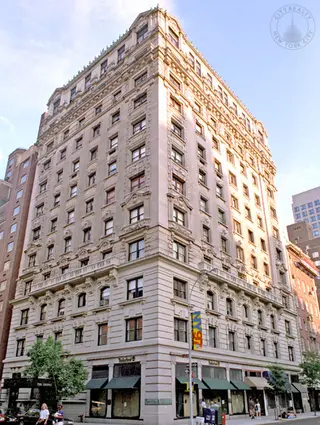 Carter Horsley
Carter HorsleyDec 23, 2011
Carter's Review
One of the most elegant apartment buildings on Madison Avenue, the Leonori originally had its entrance on the avenue but when retail space on the avenue became very valuable it replaced the entrance with store space and created a new entrance on the side-street. (The apartment building at 45 East 66th Street also moved its entrance off the avenue for the same reasons.)
The building's original entrance on the avenue had a very handsome portico that was somewhat similar to that of the apartment building at 667 Madison Avenue that was unfortunately demolished for an office building. The 10-story apartment building at 667 was built in 1900 and the next year plans were filed by Maximilian Morgenthau for this 12-story building, which would be the avenue's tallest on the Upper East Side at that time.
This limestone-clad building was completed in 1902 when its address was 701 Madison Avenue. It was designed by Buchman & Fox. It was designed as an apartment hotel with a rooftop dining room. Morgenthau leased it in 1902 to Charles L. Leonori, after whom the building was named.
In a February 14, 1988 article in The New York Times that is reprinted in his fine book, "Changing New York, The Architectural Scene" (Dover Publications, Inc., 1992), Christopher Gray noted that the 1922 replacement of the avenue lobby with storefronts with iron Ionic pilasters was designed by Jardine, Hill & Murdoch, "the best work of its type on the avenue."
"In 1925," Mr. Gray continued, "the dining room was moved to the ground floor and opened to the public as a restaurant, freeing space for penthouse apartments, then coming into vogue. by this time the major elements of the building had been changed except for the rooms and the late Victorian finishes - sliding doors, dark wood trim, heavy ornamentation - now out of fashion in an era of light colors and neo-Georgian detailing....In 1981, a real-estate investment group headed by David Berley bought the Leonori and converted it to condominium ownership in 1983."
The building was included in the Upper East Side Historic District, given it landmark status, but incredibly the building at 667 Madison Avenue was not and it was demolished by Leonard Stern to make way for a new office building that is attractive but in no way as elegant as the apartment building with its great caryatid statues above its portico that it replaced.
The building has 67 apartments, a three-story rusticated limestone base, a marquee side-street entrance with a walk-up lobby, some arched windows, and sidewalk landscaping, but no garage and no health club.

- Condo built in 1901
- Converted in 1983
- Located in Park/Fifth Ave. to 79th St.
- 67 total apartments 67 total apartments
- 10 recent sales ($379K to $8.9M)
- Doorman
- Pets Allowed
 6sqft delivers the latest on real estate, architecture, and design, straight from New York City.
6sqft delivers the latest on real estate, architecture, and design, straight from New York City.
